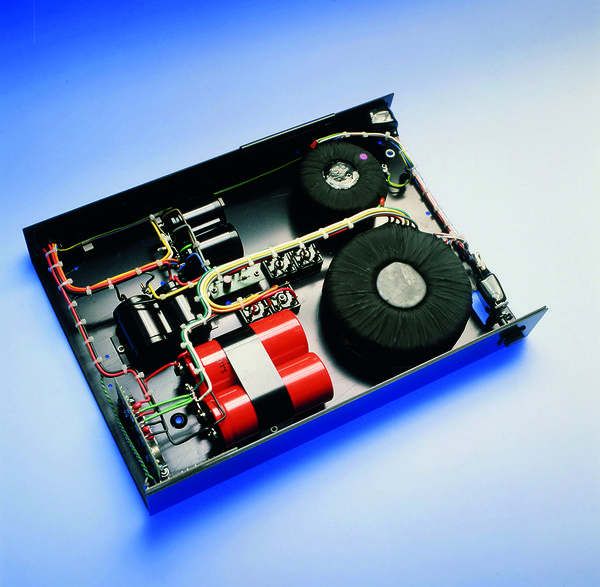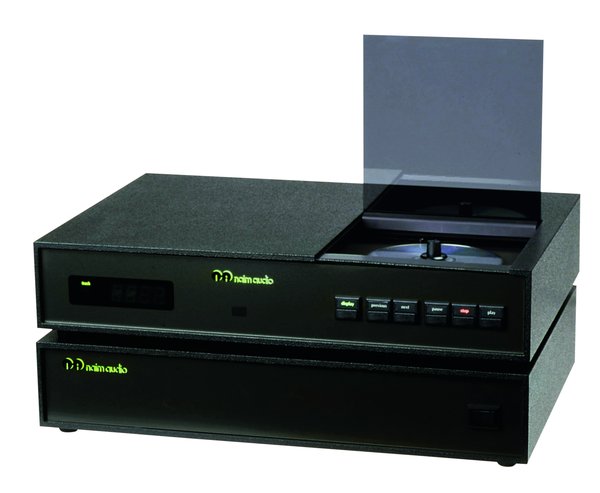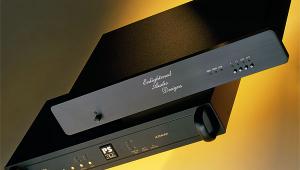First Naim turns

My patience was put to the test with the Naim CDS. As I unpacked the two units and coupled them together I experienced a flush of old 'brand loyalty'. Since the days of the original 12S preamp and NAP160 power amp, my meetings with company founder Julian Vereker had been cordial and I had spent several pleasurable years with my NAP250. My frustration came with the waiting time for the player to warm up before listening began.
Costing £2937, this first Naim CD player is a top-loading, two-box design linked with a 13-pin locking umbilical, some 12mm in diameter and 1.45m long. This suggested spacing the units apart rather than stacking and, as suggested by Naim, care was taken over support/ isolation. I used a Russ Andrews Torlyte stand, with the dedicated power supply box remotely sited also on Torlyte. Unlike most two-box units, which separate the converter, the CDS has the transport and electronics together since this eliminates one source of jitter.
Crackle 'N' Pop
The transport/laser floats in the usual way, but here the main circuitboard is also compliantly mounted, and locks for transit purposes. The only outlet is the 180o 5-pin DIN socket, which delivers an analogue signal to a preamp, while the mains on/off is to the right of the PSU fascia.
The CDS sports a black crackle finish over a 5mm-thick sleeve and measures 430x45x300mm (whd). The fascias, meanwhile, are dark-olive plastic laminate with the Naim logo back-lit in green. The player has a top cutout for the pop-up black Perspex lid to the CD compartment (an accessory clip is provided for use when dealing with the top/bottom suspension screws) and a chunky remote control handset is supplied.
 Inside the
case containing
the power supply
resided two beefy
transformers, one
for the analogue
electronics, the
other for the
player’s digital
components,
transport and
servos
Inside the
case containing
the power supply
resided two beefy
transformers, one
for the analogue
electronics, the
other for the
player’s digital
components,
transport and
servos
Thimble Tricks
In 'load' position, the display, which could hardly be described as discreet, shows total timing or track numbers, while in 'play' it shows selected track (and index) or elapsed time. Indices, which are less common nowadays, can only be addressed using the fast-forward/reverse keys. These allow you to monitor the signal by ear. On the player itself, the illuminated push-button controls are sequenced in order: display (this cannot be switched off), previous, next, pause (red), stop (red) and play.
When swapping over discs, a technique of 'palming' the thimble-sized puck and removing the disc with the same hand is quickly learned. Irritatingly, on this machine you cannot start a selected track on a newly inserted CD without keying 'play' in addition to the track number. Compared with Meridian transports, although programme/repeat facilities are the same, those for indexing and residual timing are absent. On the other hand, the response when changing tracks is far quicker than in Meridian's 200. Unlike the Meridian unit, pressing 'play' during a track recommences that track, rather than accessing the next one.
Impressive in build, the Naim CDS player suffers in a domestic setting from a distractingly unrelated pattern of coloured lights, and the spurious index display, eg, 1.00 changing to 1.01 is, to my eyes, visually crude.
Dark Star
An entirely independent assessment made by Editor Steve Harris follows this report, but let me say at the outset that I enjoyed every minute of listening to the CDS, within its evident parameters. Analogous to the best bitter chocolate, the CDS has its own distinctive, powerful, smooth and dark character. The very first disc I tried, the Dorati/LSO 'Second Viennese' programme [Mercury] confirmed a precision in placement of instruments, the fact that one is immediately drawn into the music, and that subtle rhythmic patterns are sharply defined. This wasn't a light, airy sound but one that was full in the bass registers, while shrill fortes were smoothed over, making them easy to accept. No-one could miss points of interpretation, since these are often changes of pace (particularly with pianoforte), and rhythmic integrity is the key strength of the CDS. It derives, to my mind, from the design attention given to immunity to vibration and to robust power supplies.
 Although
a two-box player,
the CDS wasn’t
split along the
traditional
transport/
processor lines.
Rather, the top
box as pictured
housed the DAC
and transport
while the bottom
one contained the
power supply. The
two boxes were
connected via a
multi-pin umbilical
Although
a two-box player,
the CDS wasn’t
split along the
traditional
transport/
processor lines.
Rather, the top
box as pictured
housed the DAC
and transport
while the bottom
one contained the
power supply. The
two boxes were
connected via a
multi-pin umbilical
Credit Score
The dark phantasies of Chausson's Poeme, in Joshua Bell's Decca recording [433 519-2], made for compelling listening, and scoring details which I had not been conscious of before were now apparent. However, this was at the expense of other important sonic qualities. Full strings had an unwelcome glaze, Bell's instrument taking on a viola-like heaviness.
In direct LP/CD comparisons with Clannad's Magical Ring, I thought the CDS foreshortened the depth layerings (and smoothed the dramatic thrust) of 'Newgrange', and compressed the harp on 'Fairy Queen'. And with the Boston Symphony Hall Strauss Don Quixote 'Knight's Vigil', I thought there were serious losses in the sense of space when it came to the shadings of timbre of the cello and tuba interjections, while Yo-Yo Ma's breathing noises could be identified as such yet they no longer conveyed the intensity of his concentration. It was as if the musical experience had become rounded off.
Another testing disc, Mozart's Piano Quartets on authentic instruments [Archiv], disappointed with a solid, phlegmatic character at odds with both the nature of the performances and of the recording as I know it. Despite this, and the coarsening of the string attacks, I remained attentive to the playing and to the music's progress.
One final example was a complex passage from Mahler 5(iii) [Haitink/ Philips]. Here the CDS showed its undoubted ability to make plain the structure and composition of texture. Yet there is another aspect of recorded sound, and that is the resolution of the scale and ambience of the setting, and precise colouring of instrumental/voice timbres. This projects the listener not just into the score itself (no criticisms of the CDS on that) but also into those distinctive areas which make you choose one version over another. Some 4m into the Mahler Adagietto, and you ask yourself 'can these be the strings of the Berlin Philharmonic sounding in the Philharmonic? They could come from anywhere'.
Naim Versus Linn
In the same price region, though a far less imposing package visually, Linn's Karik/Numerik duo made a necessary comparison here. When literally cold, straight out of the boxes, the Linn player nevertheless showed a somewhat more neutral resolution of timbres. As one grew more familiar with its performance it could be said that the darkness of the CDS is here replaced by a lightweight character of sound. The start of Berg's Op.6 had a deep, wide setting yet ambient focus was nevertheless blurry. Whereas the Naim player was engaging, the Linn was less than that. On the Strauss soliloquy, the cello was alarmingly more forward, more spread, though Yo-Yo Ma's intakes of breath were readily identifiable and one was very aware of string vibrato durations. From some 5m 40s into the BPO Mahler 5(iii) the brass exchanges across the back of the stage suggested inferior-quality instruments!
Conclusion
The Naim CDS is an extremely costly product, but I suspect it would not be difficult with selected examples to impress a customer happy with the £3k price tag. With music where delicacy and spatial resolution are the requirements, one would have to look elsewhere.
Linn-Naim devotees should listen most carefully to the differences between the CDS and Karik/Numerik, to gauge long as opposed to short-term gains/losses. In my view, more accurate resolution than with either player can be obtained for slightly less outlay.
 Some
six years after the
launch of the CDS,
Naim replaced its
flagship CD player
with the CDSII.
While outwardly
a dead-ringer for
its predecessor
and again a toploading,
two-box
design, the CDSII
[HFN Jan ’99] used
a transport from
Philips’ CDM12
series along
with Burr-Brown
PCM1702-K DACs
Some
six years after the
launch of the CDS,
Naim replaced its
flagship CD player
with the CDSII.
While outwardly
a dead-ringer for
its predecessor
and again a toploading,
two-box
design, the CDSII
[HFN Jan ’99] used
a transport from
Philips’ CDM12
series along
with Burr-Brown
PCM1702-K DACs
A Second Opinion
A reviewer of the CDS [writes Steve Harris] should probably try it in an all-Naim system, as Naim intended, but I went straight into the comparison that to me seemed the most relevant and intriguing. I listened to the CDS against the Linn Karik/Numerik. On the old standby 'Easy Money' from Rickie Lee Jones [Warner 256 628], the CDS scored immediately. The finger-noises heard on Red Callendar's double-bass intro seemed more realistic, more naturally associated with the intentional sounds of the instrument. Other minor details of the mix came into focus in a similar way, the piano seeming to phrase rhythmically rather than just tinkle. Also, the bass and drums were consistent throughout the track, convincingly acoustic-sounding and producing the most unforced, foot-tapping rhythm I've heard from CD.
Turning to Uchida's Debussy 12 Etudes [Philips 422 412-2], Naim's player conjured up a pianist full of verve, playing with breathtaking dynamics. The piano seemed very firmly placed, the original sound of the notes clear and the echo-responses of the reverberant hall clearly distinguishable.
On these two very different discs, I would have given the CDS quite a few more marks than the Karik/Numerik. The latter did a good job of putting over Rickie Lee's voice, with all its nasal delicacy, and there was a fair degree of 'bounce' to the rhythm section. Yet there were times when the double-bass subtly failed to sound like an acoustic instrument. On Uchida's piano recording, the Linn player sounded velvety, smooth and convincing enough, but there was a loss of freedom, a squashing effect, on the loudest bits. It could sound beguilingly detailed but did not dispel all spatial ambiguity, with some uncertainty in the positional relationship of treble and bass.
On The Edge
However, it was a piano concerto recording, Mozart's K482 played by Alicia de Larrocha [Decca 410 140-2], which unexpectedly brought out the real contrasts between the two machines. Here, the orchestra seemed to play more rhythmically, with a strong pulse from drums and basses and attack from the piano, with a real sense of hammers hitting strings. And there you have it. The Naim CDS does seem to do something other CD players can't manage, but it can sometimes sound edgy compared with the smoothed-out quality of the Linn offering, and there is less timbral 'correctness' to some instruments than with other reasonably refined players.
The Linn player justifies its existence in terms of ease of use, system compatibility and constructional integrity, and its sound does offer that cardinal virtue of stability which, combined with a good level of detail and freedom from hardness, makes it a genuinely listenable player. The Naim CDS, on the other hand, is a purist design, and an idiosyncratic one. But I feel that this machine is at least a pointer to what can be achieved.
Lab Report
Naim's implementation of Philips' classic 16-bit/4x oversampled chipset [writes Paul Miller] is unlike any earlier design thanks, on the whole, to its proprietary 7-pole analogue filter. Hence we still see a slight in-band ripple on the frequency response (from the digital filter) with a drop of 0.47dB at 20kHz as the output filter begins to bite. The 3D and -70dB plots revealed the effectiveness of this analogue filter in suppressing stop-band sampling products, but the spurious lines showed susceptibility to radiated interference.
Distortion at low and midrange frequencies (0.0013% at 0dB) is typical of the Philips chipset, though this increases to 0.025% at 20kHz with a strong 2nd harmonic component from the analogue section. The Naim player's linearity also suffers a slight kink at -90dBFs with a deviation of some 5.76dB, which is a poor result for Philips' TDA1541A DAC. The A-wtd S/N ratio of 109dB, though perfectly adequate, is also 4-5dB behind the best 16-bit implementations. In short, I would expect the sound of this player to be strongly influenced by its analogue electronics.
























































